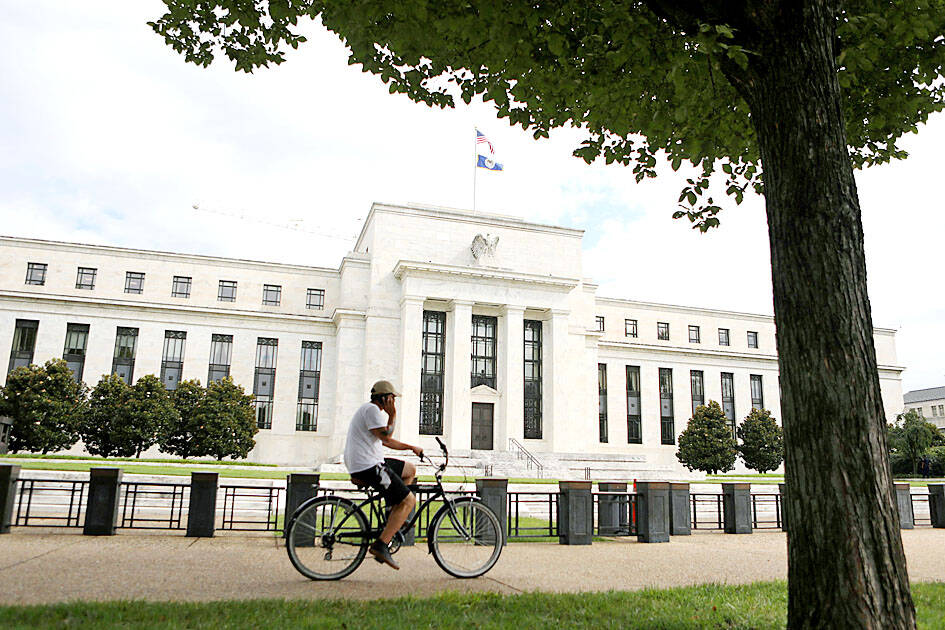The US Federal Reserve is widely expected to hold interest rates steady on Wednesday after a summer of mixed economic data, while leaving the door open to another hike if needed.
The Fed has raised interest rates 11 times over the past 18 months, lifting its key lending rate to a level not seen for 22 years as it tackles inflation still stubbornly above its long-term target of 2 percent.
Analysts and traders broadly expect the US central bank to hold rates steady on Wednesday in order to give policymakers more time to assess the health of the world’s largest economy.

Photo: Reuters
“We think the Fed is done with its tightening cycle,” Ernst & Young chief economist Gregory Daco said.
“That view has not changed over the past couple of months,” Daco said.
The rate-setting Federal Open Market Committee (FOMC) finds itself in a difficult situation as it seeks to address inflation through interest rate hikes while avoiding a recession, a feat that economists call a soft landing.
Recent economic data showing strong economic growth in the first half of the year, inflation trending downward, and a softening jobs market suggests the Fed might just be able to pull it off.
“I think, in general, the economy is doing relatively well, but we are seeing signs that there is an economic slowdown underway,” Daco said.
Analysts at Goldman Sachs Group Inc recently cut their forecast for a recession in the US from 20 percent likelihood down to 15 percent, while other economists — including those in the Fed’s research team — say they no longer expect the US to enter a recession.
“Recent data should leave the Fed encouraged by ongoing disinflation but concerned about re-acceleration in inflation because of the strength in activity,” Bank of America Corp economists wrote in a note to clients.
“We expect participants to retain a bias toward one more rate hike as they did in June,” KPMG US chief economist Diane Swonk wrote in a recent blog post.
“The Fed is not ready to abandon its higher-for-longer mantra until it achieves a more sustained drop in inflation,” she added.
Traders currently assign a probability of more than 95 percent that Fed will hold its key lending rate at its current level of between 5.25 and 5.50 percent on Wednesday, according to data from CME Group.
Even if the Fed ultimately chooses not to hike in November, its decision to forecast another hike this year could nevertheless serve a useful function, analysts say.
“The last thing that Fed policymakers want is for markets to price the end of the tightening cycle, because it will then infer that the next move will be lower — essentially rate cuts,” Daco said.
Ernst & Young still expects this month’s pause will morph into the end of the current hiking cycle, leaving already-high interest rates to do the necessary work to bring down inflation.
“Factoring forward-looking perspectives on employment, on inflation, will essentially lead the Fed to prolong its pause,” Daco said.

The US dollar was trading at NT$29.7 at 10am today on the Taipei Foreign Exchange, as the New Taiwan dollar gained NT$1.364 from the previous close last week. The NT dollar continued to rise today, after surging 3.07 percent on Friday. After opening at NT$30.91, the NT dollar gained more than NT$1 in just 15 minutes, briefly passing the NT$30 mark. Before the US Department of the Treasury's semi-annual currency report came out, expectations that the NT dollar would keep rising were already building. The NT dollar on Friday closed at NT$31.064, up by NT$0.953 — a 3.07 percent single-day gain. Today,

‘SHORT TERM’: The local currency would likely remain strong in the near term, driven by anticipated US trade pressure, capital inflows and expectations of a US Fed rate cut The US dollar is expected to fall below NT$30 in the near term, as traders anticipate increased pressure from Washington for Taiwan to allow the New Taiwan dollar to appreciate, Cathay United Bank (國泰世華銀行) chief economist Lin Chi-chao (林啟超) said. Following a sharp drop in the greenback against the NT dollar on Friday, Lin told the Central News Agency that the local currency is likely to remain strong in the short term, driven in part by market psychology surrounding anticipated US policy pressure. On Friday, the US dollar fell NT$0.953, or 3.07 percent, closing at NT$31.064 — its lowest level since Jan.

The New Taiwan dollar and Taiwanese stocks surged on signs that trade tensions between the world’s top two economies might start easing and as US tech earnings boosted the outlook of the nation’s semiconductor exports. The NT dollar strengthened as much as 3.8 percent versus the US dollar to 30.815, the biggest intraday gain since January 2011, closing at NT$31.064. The benchmark TAIEX jumped 2.73 percent to outperform the region’s equity gauges. Outlook for global trade improved after China said it is assessing possible trade talks with the US, providing a boost for the nation’s currency and shares. As the NT dollar

The Financial Supervisory Commission (FSC) yesterday met with some of the nation’s largest insurance companies as a skyrocketing New Taiwan dollar piles pressure on their hundreds of billions of dollars in US bond investments. The commission has asked some life insurance firms, among the biggest Asian holders of US debt, to discuss how the rapidly strengthening NT dollar has impacted their operations, people familiar with the matter said. The meeting took place as the NT dollar jumped as much as 5 percent yesterday, its biggest intraday gain in more than three decades. The local currency surged as exporters rushed to